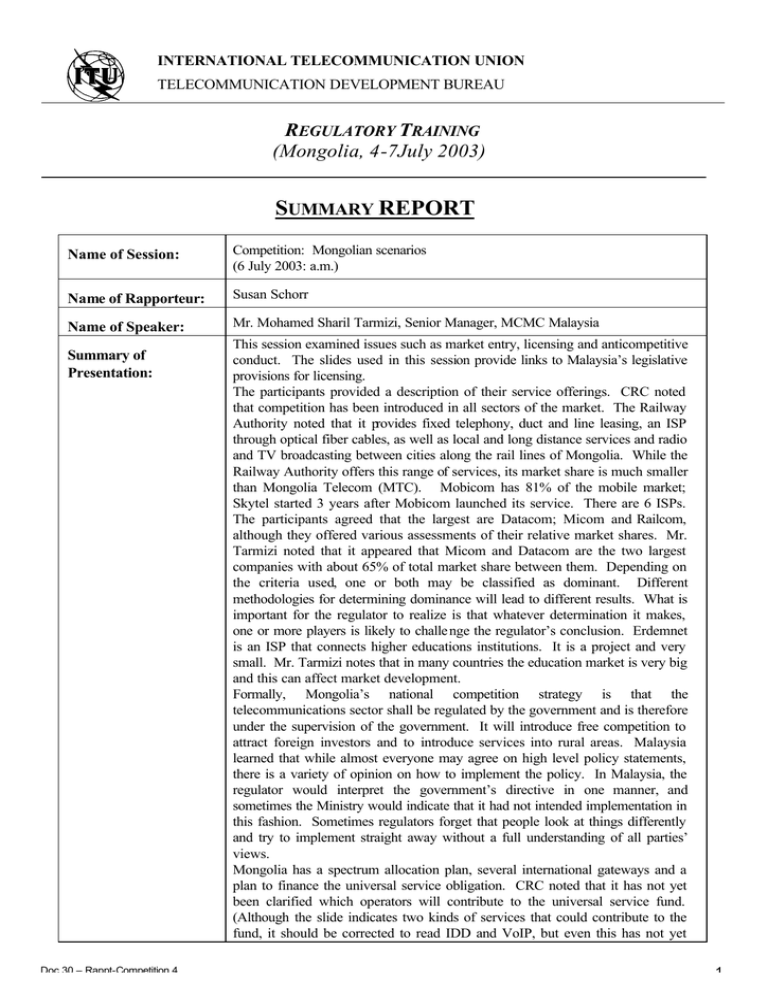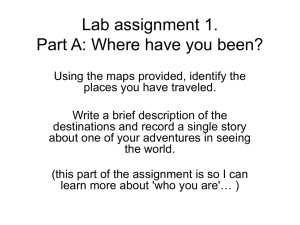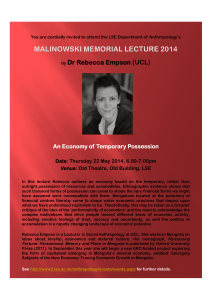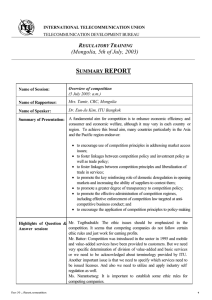S REPORT R
advertisement

INTERNATIONAL TELECOMMUNICATION UNION TELECOMMUNICATION DEVELOPMENT BUREAU REGULATORY TRAINING (Mongolia, 4-7July 2003) SUMMARY REPORT Name of Session: Competition: Mongolian scenarios (6 July 2003: a.m.) Name of Rapporteur: Susan Schorr Name of Speaker: Mr. Mohamed Sharil Tarmizi, Senior Manager, MCMC Malaysia Summary of Presentation: Doc.30 – Rappt-Competition 4 This session examined issues such as market entry, licensing and anticompetitive conduct. The slides used in this session provide links to Malaysia’s legislative provisions for licensing. The participants provided a description of their service offerings. CRC noted that competition has been introduced in all sectors of the market. The Railway Authority noted that it provides fixed telephony, duct and line leasing, an ISP through optical fiber cables, as well as local and long distance services and radio and TV broadcasting between cities along the rail lines of Mongolia. While the Railway Authority offers this range of services, its market share is much smaller than Mongolia Telecom (MTC). Mobicom has 81% of the mobile market; Skytel started 3 years after Mobicom launched its service. There are 6 ISPs. The participants agreed that the largest are Datacom; Micom and Railcom, although they offered various assessments of their relative market shares. Mr. Tarmizi noted that it appeared that Micom and Datacom are the two largest companies with about 65% of total market share between them. Depending on the criteria used, one or both may be classified as dominant. Different methodologies for determining dominance will lead to different results. What is important for the regulator to realize is that whatever determination it makes, one or more players is likely to challe nge the regulator’s conclusion. Erdemnet is an ISP that connects higher educations institutions. It is a project and very small. Mr. Tarmizi notes that in many countries the education market is very big and this can affect market development. Formally, Mongolia’s national competition strategy is that the telecommunications sector shall be regulated by the government and is therefore under the supervision of the government. It will introduce free competition to attract foreign investors and to introduce services into rural areas. Malaysia learned that while almost everyone may agree on high level policy statements, there is a variety of opinion on how to implement the policy. In Malaysia, the regulator would interpret the government’s directive in one manner, and sometimes the Ministry would indicate that it had not intended implementation in this fashion. Sometimes regulators forget that people look at things differently and try to implement straight away without a full understanding of all parties’ views. Mongolia has a spectrum allocation plan, several international gateways and a plan to finance the universal service obligation. CRC noted that it has not yet been clarified which operators will contribute to the universal service fund. (Although the slide indicates two kinds of services that could contribute to the fund, it should be corrected to read IDD and VoIP, but even this has not yet 1 been confirmed). CRC has recently directed one provider to provide universal service in 4 rural areas. The Ministry explained that the main objective of universal service is to finance investments in the market. The Erdemnet ISP is to provide universal service to educational institutions. Mr. Tarmizi suggested that Mongolia’s current competition strategy could be made to be technologically neutral and not distinguish between data and voice. For example, Mongolia considers all international gateway providers competent to provide voice services. Mongolia, however, should consider assigning providers of VoIP services different numbers than fixed line providers. Currently the number allocations are the same with the result that consumers cannot tell by the number they dial if they are using fixed or VoIP services. Traditional routes to competition include: • Fixed to fixed • Mobile to mobile • ISP to ISP • Postal to postal • Railway to railway These all related to communications. Mr. Tarmizi asked whether Mongolia has mandated unbundling of the local loop to allow access of copper wire to other operators to enable 2, 3, or 4 operators to share the same copper wire and allow customers to choose different voice providers using the same line. CRC explained that one private operator tried to utilize unbundling, but was not successful because the parties could not reach agreement on terms and prices. CRC plans to include unbundling and infrastructure sharing in new regulations. MCMC also has had problems with unbundling and equal access because of resistance from the incumbent. After four years, MCMC has not been able to require unbundling because the incumbent interpreted the regulations in way that made it impossible to open up lines. MCMC, however, now realizes that VoIP is an alternative means to route calls and can achieve the desired result. TRAI noted that equal ease of access in India is applicable to long distance, both international and national, enabling a consumer to select the operator it wishes to route the call. New entrants in India have focused more on wireless local loop than local loop unbundling and have not yet felt the need to share the copper local loop. The facilitators noted that new technologies make access to the copper wire very attractive for ISPs and allow cross-market competition, in other words, not voice-to-voice competition but voice-to-ISP competition. This is more difficult when the voice operator is also an ISP. In Mongolia, currently only Micom, the data subsidiary of MTC, offers ADSL. Micom launched ADSL last year and has 100 subscribers, a number it seeks to increase. The Railway Authority does not yet offer ADSL, and uses its own infrastructure to provide ISP services. Erdemnet uses radio modems and dial up through MTC’s copper wires. Internet rates in Mongolia are regulated. Mr. Singh noted that dial up Internet access in India is not a problem because an ISP subscriber can dial up any ISP with whom it is registered. Local loop sharing is important to the provision of ADSL services. MCMC noted that it has also experienced problems with dial up Internet access because ISPs received preferential rates. Dial up access is offered at below cost to promote Internet access. The result was that Telecom Malaysia refused to allow interconnection to all ISPs except one. TRAI said that it is difficult to request an incumbent that also has an ISP to offer its service to competitors at below costs. India requested that its incumbent fixed line operator offer prices at local call rates. If interconnection prices are not right (i.e., below cost), operators will not fall into line with the regulatory regime. It is difficult to balance national, operator and social interests. Doc.30 – Rappt-Competition 4 2 Regulators are often required to identify bottleneck facilities or choke points to access and to control bottle neck facilities by regulating prices, setting price caps, or adopting other similar measures. MCMC maintains an access list that identifies facilities that require intervention by the regulator. The facilitator noted that technologically any competing operator could ride on MTC’s copper and offer ADSL. But would MTC give access? Mr. Tarmizi added that despite the difficulties faced by Malaysia and Mongolia, there have been successful experiences with unbundling in other countries. Unbundling may be difficult but it is possible. The question is how much effort, time and expense the regulator wishes to devote to unbundling. Mr. Singh noted that Denmark is one country that has succeeded with unbundling. Originally, when the Danish regulator tried to impose unbundling, it was challenged in court and the court ruled that the regulator had no power to act. Thereafter the Danish Parliament changed the law so there was no questioning the regulator’s power to impose unbundling. When the incumbent said it had no room to provide for collocation, the Danish regulator ordered the incumbent to construct a collocation room at its own expense. The FCC also recently issued an unbundling order. While the FCC Chairman ruled that the incumbent must share its local loops, another FCC commissioner dissented on the ground that the incumbent should not be required to sell local loops at below cost. The UK regulator has also ordered unbundling, but this has proved very difficult. Still, Mr. Singh argued that if BT can provide ADSL itself, so can competitors. The key to unbundling is to encourage revenues for the incumbent. Copper is a sunk cost. If the incumbent does not make use of it, it loses money. Moreover, Ms. Schorr noted that there are likely to be more unbundling success stories in Europe because the European Commission supports unbundling and is likely to enforce unbundling regulations in its member states. This is likely to have an impact not only in current European Union (EU) member states, but also accession states trying to join the EU. Mr. Tarmizi noted that incumbents often don’t view copper as a sunk cost and an asset that they can make use of. Thus, they try to charge prices to recover the full cost of their asset, rather than one that has been amortized. When incumbents try to charge the full cost, competitors may decide to build their own infrastructure. In Mongolia, the infrastructure belongs to the Post and Telecom Authority (PTA), which leases it. According to the agreement between PTA and MTC, MTC is eligible to lease PTA’s property to other operators. PTA’s power to lease property directly to others is limited to old analog equipment in some rural areas. Thus, unbundling is a question for MTC not PTA. . VoIP has been used as an unbundling tool in Malaysia. Long distance VoIP is provided through cards purchased by end users, which require them to dial a toll free 1 800 number. The incumbent sells the 1 800 numbers to VoIP providers. Thus, VoIP operators were gaining access to the incumbent’s lines. Although the Minister said the incumbent could not be forced to offer unbundling below cost, it did lower its international rates once VoIP operators began competing for the international call market. New technology can therefore sometimes offer solutions that may not be achieved through regulation. Allowing ISPs to use VSATs is another technological solution to the last mile issue. Mr. Tarmizi suggested that mobile competition could be advanced through mandated domestic roaming, given that Mongolia has a mobile coverage problem. This would allow each of the two mobile operator’s customers to run on another network. Technologically this not currently possible because Mongolia has both a CDMA and GSM mobile network. But equipment manufacturers are building a chip to allow roaming between these two technologies. TRAI noted that where there is economic value, technology often provides a solution. Mr. Singh noted that he was not certain that Mongolia needed a third Doc.30 – Rappt-Competition 4 3 mobile operator to meet its development goals. Australia, which is of similar size to Mongolia, but with a much larger population, has only 3 mobile operators. Mr Tarmizi suggested that Mongolia allow market pricing and market diversification, including both post and prepaid service offerings. Mongolia can examine its own data and determine how much mobile market growth followed the launch of prepaid services. MCMC found that when it deregulated prices, the operator with the smallest market share initiated a price war. While consumers benefited, some operators found it non sustainable. This is one of the reasons for Malaysia’s operator consolidation. Mr. Tarmizi agreed that while Mongolia could issue new mobile licenses, the market may not be appropriate for additional mobile operators. Mr. Tarmizi suggested that because Mongolia has already agreed to allow VoIP it could consider voice delivered over fixed, mobile and VoIP networks as one market. Mr. Tarmizi noted that there has been a lot of technological advancement with equipment that uses radio frequencies in the 2.4 GHz range to provide wireless broadband access, and prices for this equipment have come down substantially. In addition to being used for “hotspots” this technology also allows wireless ISPs. Wireless chip prices have come down so much that laptops and personal digital assistants (PDAs) are now available with built in access to 2.4 GHz. Wireless access cards are also very cheap. Because Mongolia authorizes VoIP it could also have wireless gateways. Mr. Tarmizi explained that he is able to use his PDA at a wireless hotspot to make voice calls. Ms. Schorr added that entire cities could become wireless hotspots using a new technological standard, IEEE 802.16 that substantially reduces costs for broadband access. Mr. Tarmizi suggested that Mongolia could leapfrog to broadband using this new technology. Mongolia can identify new technologies and think outside the box because it does not have too much of the legacy baggage to worry about in terms of its regulatory and legal framework. Thinking outside the box goes beyond wireless broadband. Because the Ministry of Infrastructure covers many different infrastructures, Mongolia could also investigate power line technology and rights of way for natural gas networks or any other networks that are already in the ground, just as it has already done for railway rights of way. Anther new technology that could be explored by Mongolia is multi level protocol switching. Mr. Singh agreed noting that power lines already go into offices and residences and is therefore a useful access medium. Siemens is working on power line solutions that come to the customer’s premises. This technology is akin to unbundling the copper wire on power line. Power line technology can transmit voice and data. It cannot yet be used for TV transmission. The question is how soon it will come out of laboratory. Mongolia’s advantage is that is has a single Ministry that could order all of this to happen. This is difficult in India where there are Ministries with overlapping functions and which disagree about who controls what medium. Mongolia could benefit by the coordination of the multiple sectors that are covered by MOI. Mr. Tarmizi noted that the Malaysian regulatory framework may be too complicated for Mongolia’s smaller market, especially since Mongolia has already included facilities-based and services-based licensing in its legal framework. Nevertheless, CRC has to ensure a level playing field. Different facilities based operators should operate under the same rules. The concept of technological neutrality can be applied across the board, to cross sectors, to ensure that the same rules and agreements apply to everyone. Market distortions such as special rights or subsidies should be avoided. While Mongolia could consider reorganizing its market as Malaysia did by content services, applications services, network services and network facilities, Mongolia’s facilities based and services based framework is more similar to the Singapore model. Now, Mongolia must decide how it wishes to map its Doc.30 – Rappt-Competition 4 4 services. For example, were Mongolia to allow blanket WiFi and consumers begin using their PDAs to access email, voice and the Internet, how would Mongolia classify the operator that makes all of these services available? Voice, Internet or something else? Mr. Singh noted that although the fax was invented before the telephone it took almost 100 years for fax use to become prevalent. Email is faster, having been invented only in the 1980s. Its inventor never imagined that email and the Internet would go as far as they have. Early technology needs a critical mass. Technology is only a tool. How to make use of this tool depends on your innovation and imagination. Some applications may be suitable for a certain place and not another. Mr. Tarmizi noted that Mongolia’s law appears to allow it the flexibility to offer many different options; still some inequities probably should be addressed. --Re domestic roaming for mobile operators, Mr. Tarmizi noted that there are Highlights of Que stion many approaches. One approach could be operators sharing network & Answer period: infrastructure. Traditional roaming is a vertically integrated operator providing access to another operator. The most basic approach is the collocation or sharing of transmitters, cabins or power supply. There can also be domestic roaming or sharing at the transport layer, when carriers allow interconnection or interoperability. A third kind of domestic roaming is when one service provider rides on another’s network as is the case with mobile virtual network operators (MVNOs). This is where an application service provider obtains access to a network service. It may buy airtime from one operator in Location A and airtime from another operator in Location B. A VoIP operator could become a MVNO operator. Mr. Singh explained that domestic roaming in India is different than in Malaysia. India is divided into 21 circles or provinces. Mobile operators have circle specific license due to the size of the country and its population density. When a mobile subscriber from circle 1 calls to circle 2, the two mobile operators can only be connected through the national long distance operator. All mobile operators have therefore signed roaming agreements with each other. Long distance is national, and there are four long distance operators. Cellular operators can choose any of them. Domestic roaming in Malaysia is very difficult to achieve as unlike India, the licences issued to mobile operators are nationwide, but Malaysia did it because certain mobile operators enjoyed exclusive land rights and would not provide access to other mobile operators. Thus Malaysia identified 3 key areas for mandatory domestic roaming: tourist resorts, industrial parks and along the highway. One mobile operator owns tourist resorts and doesn’t allow anyone to build towers there. Likewise, the highway operator has exclusive land rights north to south. Domestic roaming initiated a number of inter billing issues. Domestic roaming charges are a big issue in Malaysia . --Re the regulation of domain names, the authorities responsible for domain names in Malaysia is the MCMC and internationally, this responsibility currently rests with the Internet Corporation for Assigned Names and Numbers (ICANN). ICANN, he explained, is the global organization that manages the domain name system. . ICANN is a private U.S. corporation. Some governments don’t agree that a private corporation should be responsible for domain names. One of the biggest debates occurring in the preparations for the World Summit on the Information Society (WSIS) is whether Internet governance should be the provenance of the private or public sector. In other words, should it be private or intergovernmental? Mr. Tarmizi is on the board of ICANN and chairman of its Government Advisory Committee (GAC). Other GAC members are governments, the ITU, the OECD, WIPO, telecommunications and post authorities, and specialized government agencies.. --Re how regulators can support and encourage new market entrants, Dr. Kim noted that from a policy perspective, this may be supported by going from a Doc.30 – Rappt-Competition 4 5 Recommendations (if any): Doc.30 – Rappt-Competition 4 monopoly to duopoly to even more competition, should the government decide to take a step-by-step approach. In terms of regulatory aspects, it can be achieved through licensing and pricing, e.g., by applying benchmark pricing for interconnection. Mr. Tarmizi noted that it is necessary to take stock and make an assessment, to ensure that the same rules are applied both to incumbents and new market players, except to control against dominant operators. --Re the utilization of 2.4 GHz spectrum which, in Mongolia, could be used for TV broadcasting, making people conscience of whether it should be licensed or not, Mr. Tarmizi explained Malaysia first considers the treatment of 2.4 GHz as an assignment of spectrum, which is a right to use an economic resource. Operators using 2.4 GHz spectrum are given class licenses. The equipment that uses this spectrum is not controlled in part because it is becoming ubiquitous. Europeans attending the ITU World Radiocommunication Conference sought to limit the use of some spectrum in the 5 GHz range. A compromise calling for preference to be given for indoor use of equipment in this range was reached. • Identify network access bottlenecks and develop appropriate competitive safeguard tools, such as mandated pricing. • Consider de-regulating consumer tariffs especially for mobile communications to enable operators with a small market share to use pricing to increase its customer basis. • Authorizing additional mobile operators may not necessarily be appropriate for Mongolia, considering its relatively small population compared to its la rge geographic size. • Because Mongolia already authorizes VoIP, it could consider all voice services, whether provided over fixed, mobile or VoIP as one single market. • Consider leapfrogging to broadband access through new wireless IP technologies. Thinking outside the box is possible because Mongolia already authorizes VoIP. • Thinking outside the box could also be extended to power line technology as well as gas line and any other networks in the ground that may provide rights of way that can be used for telecommunications. Mongolia is ideally suited to benefit from such technology because it has one Ministry responsible for tourism, power and communications that could order that all available technologies be used to achieve national ICT development goals. • Regulatory solutions that require the incumbent to offer its services to competitors at below cost do not often succeed. Still, it is important that the regulator conduct an analysis of “below cost” to ensure that the incumbent does not seek to recover full costs from its competitors, rather than amortized costs. 6



